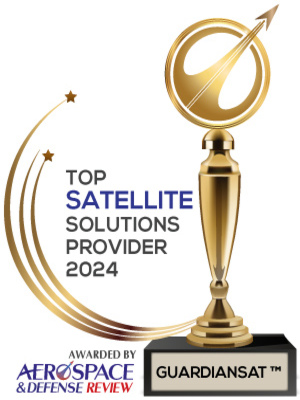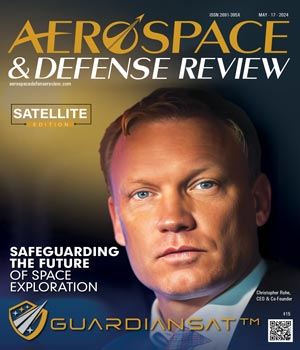THANK YOU FOR SUBSCRIBING
 Christopher Rohe, CEO & Co-Founder
Christopher Rohe, CEO & Co-FounderBut what separated Robert Briskman, Christopher Rohe, and Huey Wyche II was more nuanced: their place and phase of life during an unforgettable day in the history of space exploration—the 1986 Challenger explosion. The excitement that turned into a plume of smoke in a mere 73 seconds became an enduring memory, shaping their perspectives on space explorations and human endeavors.
Briskman, a founding member of NASA, had bid farewell to COMSAT and had just donned the role of VP of Engineering at Geostar Corporation, and Rohe was a budding program manager at the U.S. Air Force. Wyche, the youngest of the trio, was still in daycare at Cape Canaveral. Little did they know what separated these enthusiasts would ultimately bring them together, with the shared passion for driving safety and innovations and, importantly, keeping space open for all new-gen explorers—a task easier said than done.
For Briskman, the Challenger explosion became another incident that reinforced his passion for creating a safe environment where exploration activities remain dynamic. A Comprehensive Cataloging of Space Environments will Play an Important Role in Determining Debris Ownerships, Which is Integral for Making Pragmatic Global Policy Decisions and Assigning Responsibility
Hitting the Trail of a New Alliance
As a visionary, Briskman’s latest act is facilitating space traffic management (STM) and space situational awareness (SSA), which took him to Rohe. His network of experts described Rohe as ‘the right person to carry the vision forward.’
Rightly so, Rohe has honed expertise in sensor development and air traffic management. His efforts were centered on commercializing governments’ business practices. He ensured the best technologies reached the military and government to uphold national safety and stability.
“Our initial encounter was a game-changer, as we discussed the need to spearhead the space economy without compromising national safety and security,” says Rohe.
-
The Projected Annual Revenues from GEO Satellites are Expected to Surpass $150 Billion By 2030, and we are at the Forefront of Driving this Growth by Implementing Self Protection Systems and Advanced Countermeasure Mechanisms on Satellites. This Will Guarantee a Safe Sustainable Expansion of the Space Economy
Adding Rohe to GuardianSat’s founding teams enhanced the scope of its missions. With Briskman as the cartographer and Rohe as the navigator, the team still needed a tech specialist to bring their visions to life. Wyche was the ideal match.

Wyche was part of a specialized team focused on avionics and aircraft electronics, tasked with enhancing and optimizing aircraft performance and functionality. His works involved updating altitude measurement systems, integrating modernized systems onto aircraft like the C-130 and helicopters, and retrofitting older aircraft with advanced technology like glass cockpit displays. Wyche’s pivotal role ensured the seamless integration of these upgraded systems, resulting in a precision improvement from a 5 percent tolerance level to an impressive 0.03 percent. With a track record of successful improvement projects, his talent caught the eye of Rohe. Together, the trio formed the brains of GuardianSat.
Led by this star-studded team, the company stands as a trailblazer for sustainable and efficient space traffic management in GEO.
Innovations for Orbital Over-watch
Rooted in Briskman’s legacy and expertise, GuardianSat ensures the openness and safety of space by excelling in SDA, preventing satellite collisions, defending against hostile threats, and elevating space operations through innovative data engineering and AI solutions. Its mission is to “Keep Space Open” for all.
Staying true to this goal, the company’s efforts are focused on SDA and On-Orbit Defense (O2D), encompassing passive and hostile GEO challenges and beyond. The approach entails developing patented onboard satellite systems that serve dual purposes of identifying, cataloging, tracking, mapping, maneuvering, and repositioning satellites to proactively avert catastrophic events like collisions and hostile attacks. The firm safeguards physical assets through the patented payload and offers data-as-service in GEO through its generative AI pathfinder program.
“Since the early 2010s, the team has taken guidance from future clients to validate and verify our solutions and protect the implementation process and procedure to ensure a robust operating constellation beginning with the development of the Pathfinder system,” says Rohe.
As a mission-driven, leading space innovations company focusing on novel and transformative technologies, GuardianSat now holds two globally recognized patents—Systems and Methods for Autonomous Protection of Satellite from Hostile Orbital Attackers and Autonomous Satellite Orbital Debris Avoidance Systems and Methods. The technologies are designed to enhance SSA and STM, paving the way for efficient use of orbital slots, enhancing communications reliability, and reducing operational risks.
Track. Predict. Evade. Notify
Leading GuardianSat’s solution lineup is its Automated Debris Detection and Avoidance system. It comprises proprietary subsystems that identify, track, and autonomously adjust the satellite’s course to prevent collisions with fast-moving orbital debris.
“In space, objects predominantly deemed as harmless pose significant dangers due to their high relative velocities,” says Rohe. “We’ve taken the lead in mitigating these growing problems of space debris in the GEO realm, crucial for maintaining a sustainable space environment.”
To give satellites 360-degree awareness of their surroundings, GuardianSat takes a multi-spectral approach, merging LiDARs and RADAR sensors. The former measures distances with lasers, while the latter uses radio waves. Together, the system creates detailed pictures of satellite surroundings, encompassing other satellites, space debris, and even hostile objects. By layering advanced algorithms on top, the system can predict possible collision scenarios and catalog environments, providing enhanced real-time accuracy. If a collision is likely, the system takes evasive actions like firing thrusters to move satellites out of the way.
The solution also houses a reporting capability to store received sensor data, collision analysis, and maneuver performance data. This helps generate processed information reports, which will facilitate the development of a dynamic map of the orbital debris environments. Full spherical awareness, instead of a snippet, can help stakeholders make informed decisions about launch, navigation, and communication. GuardianSat’s precise satellite movement and positioning data helps establish space traffic management policies and regulations, ensuring compliance with all international space treaties and laws.

“A comprehensive cataloging of space environments will play an important role in determining debris ownerships, which is integral for making pragmatic global policy decisions and assigning responsibility,” says Wyce. “Armed with this information, decision-makers can proactively plan missions and make informed choices to avoid collisions with debris, safeguarding valuable assets in orbit.”
Satellite Security Reinvented
Accompanying its Automated Debris Detection and Avoidance System is the self-contained anti-satellite weapon countermeasure system built to neutralize ground, air, and space-based hostile attacks. The goal is to effectively address the surging developments and testing of anti-satellite (ASAT) weapons, which have largely gone unanswered in the past. This countermeasure system will provide a path to mitigate operational risk and threats associated with big-ticket investments, such as GEO satellites.
As Rohe says, “The projected annual revenues from GEO satellites are expected to surpass $150 billion by 2030, we are at the forefront of driving this growth by implementing self protection systems and advanced countermeasure mechanisms on satellites. This will guarantee a safe sustainable expansion of the space economy.”
The efficacy of patented advancements, coupled with its successful STTR Phase I effort through America’s Seed Fund from the National Science Foundation, validates and verifies the expertise and solidifies GuardianSat’s role as a thought leader.
Charting the Course for Space Sustainability
GuardianSat has devised a three-phase plan to accomplish its overarching mission — design optimization, prototype development, and pilot system launch.
Phase one confirmed the technology’s feasibility, essential for rapid response times of up to 10 seconds for active collision avoidance. Now, transitioning into the next phase, the team is developing advanced sensors and AI-based technologies to handle subsequent data. Phase three entails the construction of onboard systems and data distribution mechanisms to protect the space frame and surrounding objects.
A carefully crafted roadmap and parallel activities affirm GuardianSat’s commitment to creating a secure and sustainable space and fostering the peaceful growth of the global commons.
Given the current cislunar space bustling with private and multinational initiatives, it is not an exaggeration to say that a renewed interest in space exploration has brought a new era for the domain. After all, humans, rightly deemed the species of explorers, have been fascinated with reaching uncharted starfields since the dawn of civilization. Sharing the same innate sense to know the unknown, true to its name, the company stands as the guardian in protecting the human interest and keeping space open.
| Share this Article: |
GuardianSatTM
Company
GuardianSatTM
Management
Christopher Rohe, CEO & Co-Founder and Huey Wyche II, Technical Director; Robert Briskman, President/Co-Founder
Description
GuardianSat, a pioneer of space traffic management technology, is introducing cutting-edge systems and algorithms for real-time tracking, monitoring, and predictive analysis within the GEO. This innovative approach significantly elevates space situational awareness (SSA) and traffic management capabilities, enhancing orbital slot utilization, improving communication reliability, and reducing operational risks.






